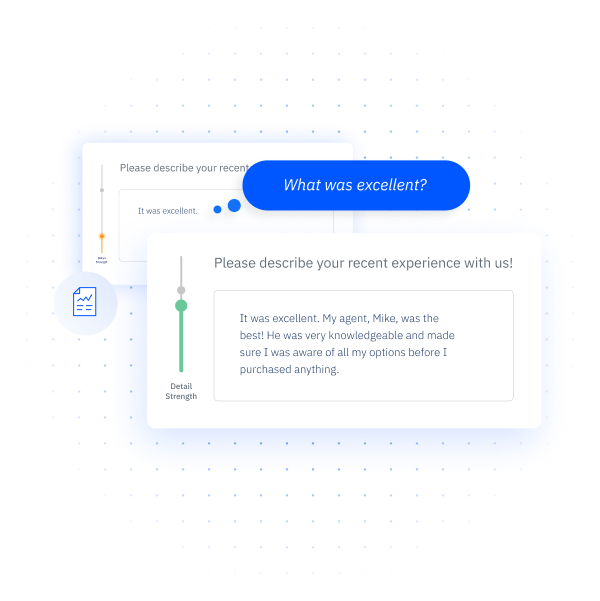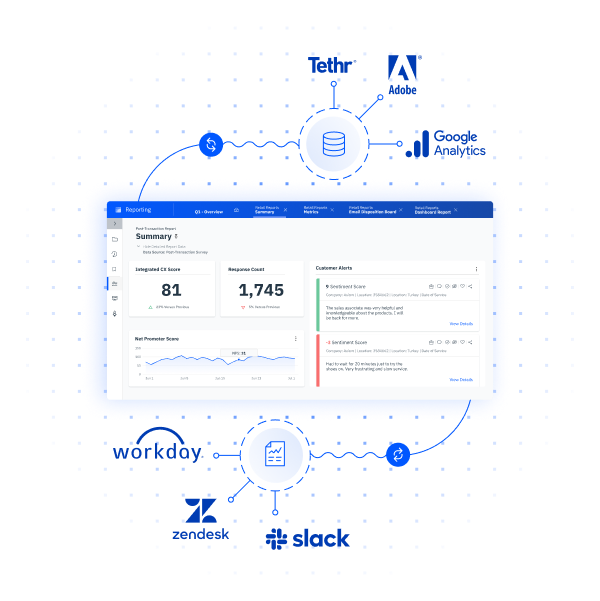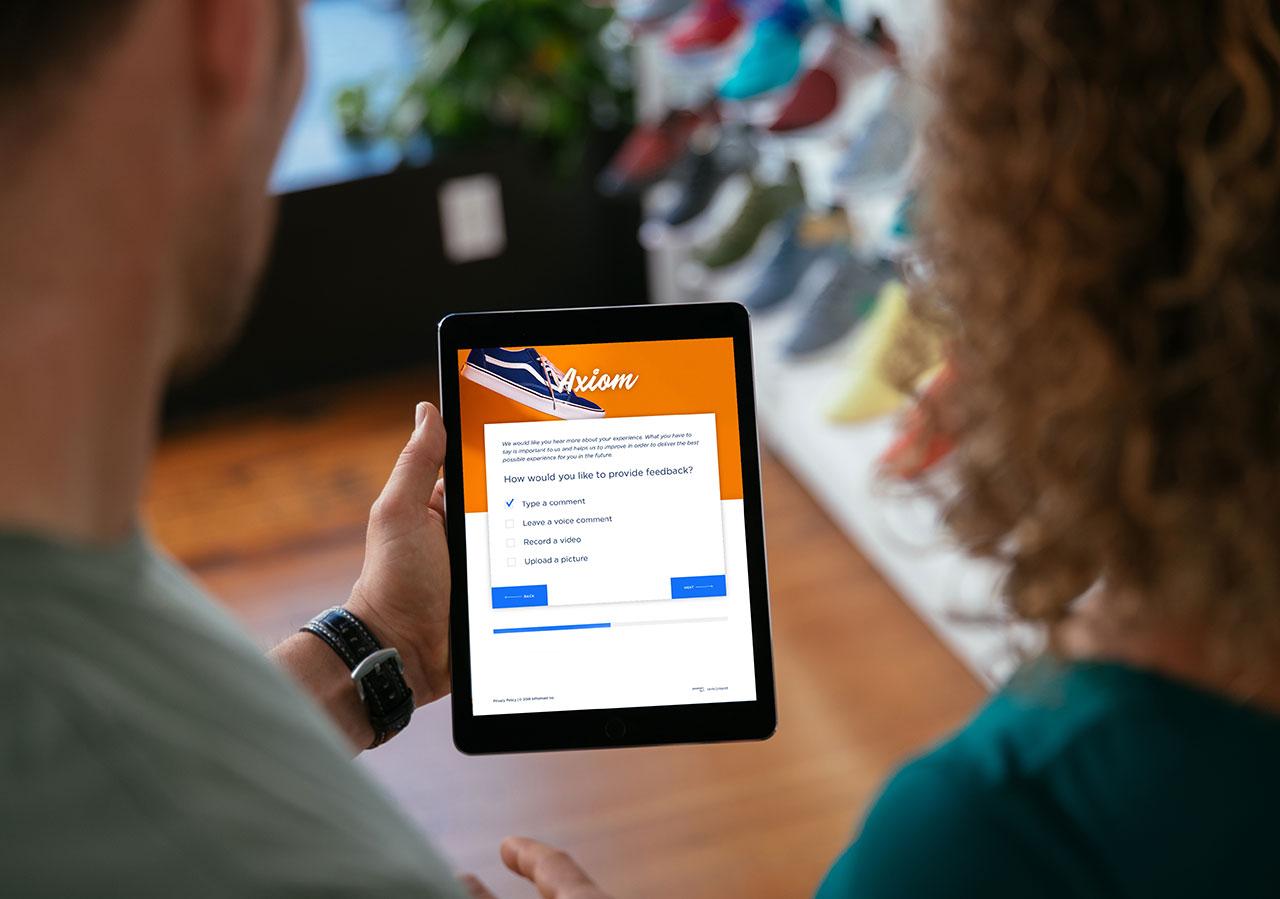User Feedback for SaaS: Best Practices & Tools for Business Success
Collecting user feedback for SaaS businesses helps improve products and customer experiences. A comprehensive feedback tool can capture the user's voice and analyze key metrics to help deliver exceptional customer service.
Customer experience (CX) is crucial to SaaS business success. Companies that focus on CX initiatives witness an 80% increase in revenue, highlighting the value of user feedback. With intense competition and changing customer preferences, businesses must better understand their users to stay ahead. Collecting user feedback for SaaS companies is a powerful step in this direction.
Why is User Feedback Important for SaaS Companies?
User feedback helps you refine your product to meet customer needs, resulting in increased satisfaction. Here are a few reasons why collecting customer feedback is important:
- It helps you build and optimize products. Your SaaS product should deliver consistent value to customers. It should address their unique pain points and help them achieve their goals.
User feedback enables continuous product improvement by highlighting customer behavior and expectations. For example, if a specific integration is in popular demand, implementing it can improve retention and satisfaction. - It boosts revenue. Happy customers are more likely to extend their subscriptions and purchase additional features. Collecting and analyzing feedback allows you to provide more value, which increases sales, subscriptions, and revenue.
- It enhances brand reputation and lead generation. Customer satisfaction results in positive reviews and testimonials. This feedback supports brand reputation management efforts, attracting high-quality prospects. Therefore, better customer service lets you generate valuable leads without stretching your marketing budget.
- It helps you stay ahead of competitors. Happy and loyal customers give you a competitive edge by consistently choosing and advocating for you over other companies. Feedback analysis also improves product strategy, ensuring you continue delivering value that retains and acquires clients.
What User Feedback Metrics Are Essential for a SaaS Company to Track?
- Net Promoter Score
- Churn Rate
- Customer Lifetime Value
- Retention Rate
- Customer Satisfaction Score
- Free-to-Paid Conversion Rate
- Customer Effort Score
- Activation Rate
- Lead Conversion Rate
Customer feedback metrics provide data-driven insight into user activity and engagement. However, deciding which KPIs in customer experience to track can be overwhelming. Here’s a breakdown of the most impactful user feedback metrics for your SaaS business:
Net Promoter Score
Net Promoter Score (NPS) is a commonly used metric that measures customer loyalty. It asks customers how likely they are to recommend your product to others, usually on a 0-10 scale.
Customers are divided into three categories based on their numerical response: detractors (0-6), passives (7-8), and promoters (9-10). The goal is to convert as many users as possible into loyal customers promoting your product and business.
You can use NPS surveys to gather responses and track the score to identify areas for improvement. Pearl-Plaza’s survey design tools enable you to quickly create custom surveys that collect user feedback for tracking NPS.
Churn Rate
Customers churn when they stop using or interacting with your SaaS product. This can happen if your product fails to deliver value and better alternatives are available. Churn rate tracks the number of customers who abandon your product within a certain period.
A good practice is to understand the drivers of churn alongside monitoring the churn rate. For example, a recent change in your pricing model could explain the uptick in churn this quarter. Leveraging a churn prediction tool can help you understand why customers might leave, which enables you to retain them before it’s too late.
Pearl-Plaza offers text analytics solutions to let you capture customer intent from their feedback. The intent appears as a complaint, praise, suggestion, inquiry, purchase, will return, comparison, requested help, recommend, not recommend, and churn. This advanced analysis helps you identify churn indicators and proactively recover at-risk customers.
Customer Lifetime Value
Customer Lifetime Value (CLV) predicts the total revenue a customer will bring your business throughout their relationship with you. This metric provides an accurate portrayal of the long-term value of the average customer. It enables you to evaluate the return on your acquisition and retention strategies.
Therefore, tracking CLV helps you identify high-value customers so that you can focus on engaging them. Retaining customers who boost your CLV will help you maximize revenue and reduce churn.
Retention Rate
Retention rate tracks the percentage of customers who renew their subscriptions to your product over a specific period. It highlights the effectiveness of your customer retention and satisfaction efforts. A high rate indicates strong engagement with your product and loyalty to your brand.
You can measure the retention rate by comparing the number of paying users at the beginning and end of a period. For example, if you start a month with 50 active users and end with 30, your retention rate would be 60%.
Customer Satisfaction Score
Customer Satisfaction Score (CSAT) measures satisfaction levels with specific aspects of your product. These interactions could include navigating your website or talking to customer support. Companies collect this data through surveys asking customers to rate their satisfaction, typically on a 1-5 scale.
Tracking customer satisfaction helps you understand how to improve the customer journey. For example, if your low CSAT is due to a clunky website experience, you should focus on improving your user interface.
Free-to-Paid Conversion Rate
While free plans are great for lead generation, paid plans drive revenue and impact your bottom line. The free-to-paid conversion rate measures the percentage of customers who shift from a free trial to a paid plan.
This metric highlights the level of customer satisfaction and engagement with your product. It also shows how well your trial plan acquires new customers. A good trial should deliver enough value to intrigue clients while withholding key features that would be well worth the upgrade.
Customer Effort Score
Customer Effort Score (CES) evaluates the effort customers put into using your SaaS product. Companies obtain this score through a CES survey, typically measuring the effort on a 5- or 7-point scale. A higher score indicates smoother product usage with low-effort interactions.
While a good product should be feature-rich, it won’t be able to deliver value if it’s difficult to use. 94% of customers with low-effort interactions intend to continue business, compared to just 4% in the high-effort category. Therefore, ease of use promotes continuous product usage, increasing retention and revenue.
Activation Rate
The activation rate measures the percentage of new users completing a key action after realizing the value of your product. These actions could include creating a profile or uploading a document.
The truth is that every product’s user activation milestone will be different, so it’s impossible to define a benchmark action. However, the common theme with these actions is that they occur due to the customer finding genuine value in your product.
Therefore, a high activation rate suggests that you are effectively onboarding customers. If you can quickly guide them to discover your product’s value, you will likely retain them. Tracking this metric can help you identify friction points in your onboarding process.
Lead Conversion Rate
Lead Conversion Rate tracks the percentage of leads that become paying customers. This metric evaluates the effectiveness of your marketing and sales teams in converting prospects.
A high lead conversion rate indicates effective marketing and a strong value proposition. Tracking this metric helps you identify issues in the sales funnel, such as unclear messaging or ineffective follow-ups. It also guides strategy on delivering value to your target audience.
How to Collect User Feedback for SaaS?
- Invest in a high-quality user feedback tool
- Use surveys to collect key CX metrics
- Collect quantitative and qualitative feedback
- Leverage the power of social listening
- Collect feedback when customers leave
- Analyze customer support tickets
- Run beta tests for new features
- Close the feedback loop
Collecting user feedback is essential for SaaS businesses to deliver better experiences. Here are a few key feedback collection strategies to consider:
Invest in a high-quality user feedback tool

A comprehensive feedback tool makes all the difference if you struggle to collect and organize your customers’ opinions. The right tool is easy to use, scalable, and rich in analytical capabilities. It helps you collect and integrate customer data from every relevant source to avoid missing out on crucial information. As a result, you can build and analyze your dataset in one place for effective decision-making.
Use surveys to collect key CX metrics
Surveys are tried-and-tested tools for collecting user feedback. By following good design practices, you can gather actionable insights without causing survey fatigue. 74% of customers are only willing to answer five questions or less in a survey. Design surveys with concise, relevant questions to capture metrics like NPS, CSAT, and CES.
A lack of personalization is another factor for low response rates. This is where Pearl-Plaza’s conversational surveys have an edge over their traditional counterparts.
These surveys work by engaging customers and responding to them in real-time. They leverage generative AI to ask follow-up questions based on customers’ previous responses. As a result of its personalized, two-way communication, this method helps collect insightful feedback.
Collect quantitative and qualitative feedback
Quantitative feedback, like NPS and retention rate, provides measurable data. It’s easy to track, analyze, and visualize. For example, a chart highlighting the trend in NPS over the last six months provides instant insight into your customer loyalty efforts.
However, quantitative data lacks context, so you can’t explain why your NPS is trending downward. Qualitative feedback provides the necessary information to better understand customer needs and expectations. For example, open-text comments from customers can reveal issues in your product that make it difficult for them to recommend you.
Leverage the power of social listening
There is only so much customer data you can collect through surveys. Social media platforms host vast amounts of unstructured feedback that can provide deeper insights into the customer experience. Comments, posts, threads, and other forms of content can feature opinions on your product, business, and competitors.
You can use Pearl-Plaza’s social listening tool to track relevant keywords and conversations across your social media channels. It monitors mentions of your brand and product to flag potential issues or highlight positive experiences. Additionally, it can perform competitor analysis by tracking what your competition is doing right or wrong. This information is crucial to building effective marketing campaigns for retention and lead generation.
Collect feedback when customers leave
It’s essential to understand why customers cancel their subscriptions or downgrade their plans. A brief exit survey can provide insight into why they decided to churn. This feedback can guide retention strategy by helping you understand what you could have done differently. For example, if pricing is a significant factor, you can boost retention by introducing flexible plans.
Analyze customer support tickets
Categorizing and analyzing support tickets helps you spot recurring issues. For example, an increase in tickets regarding a specific feature is a good sign that it requires immediate improvements.
Tag and sort support tickets by category, urgency, and sentiment. This organization will simplify the process of capturing and analyzing customer feedback. Additionally, you can track issue resolution times to see if you’re delivering timely and practical support.
Run beta tests for new features
Beta testing offers a valuable opportunity to collect feedback before a full product rollout. This helps you identify areas for improvement and address critical issues before it’s too late. It also creates a collaborative environment where users feel invested in your product’s growth.
Ask the testers to rate the product’s functionality and usability. Collect feedback on bugs that could impact the average user’s experience. Use the input to refine your product so that it’s likelier to deliver value to your target audience.
Close the feedback loop
Closing the feedback loop is essential for building trust and showing customers you care. Inform your users about any changes you make due to their feedback. You can share updates through in-app notifications or even social media posts. Leverage automation to provide instant updates to customers, saving you time to invest in stronger customer relationships.
What Key Features Should a SaaS Company Prioritize when Choosing a User Feedback Tool?
A user feedback tool simplifies the collection and analysis of customer opinions. The right software helps you make the most of each interaction with your business. Key features to look for include:
- Omnichannel Voice of the Customer (VoC): Your business will have incoming feedback from various sources, from surveys to social media channels. The right tool should pull and organize customer data from every relevant channel to provide accurate insights.
Pearl-Plaza ensures a complete view of user sentiment across all touchpoints in their journey, delivering an omnichannel customer experience. It works by collecting and connecting VoC data from everywhere so you don’t miss out on critical insights regarding customer behavior.
- Customizable Surveys: Your tool of choice should enable surveys tailored to your goals. With Pearl-Plaza’s XI platform, you can create targeted surveys for your specific audience and data collection needs. It allows you to build surveys from scratch or choose from existing templates for flexible feedback collection.
- Sentiment Analysis: AI-powered sentiment analysis helps you interpret unstructured feedback, such as reviews and comments.
Industry analysts have recognized Pearl-Plaza as a proven leader in natural language processing (NLP) with its ability to automate insights from user feedback. It helps you categorize feedback by sentiment and intent for effective CX management.
- Integration Capabilities: The user feedback tool should integrate with existing systems for smooth and seamless workflows.
Pearl-Plaza helps you break free of silos by connecting experience data with CRM systems, ticketing platforms, or project management tools. These integrations help your teams transform customer data into actionable insights.
- Real-Time Analytics and Reporting: Immediate insights into user feedback are crucial for making quick decisions. Therefore, a good feedback tool should let you visualize and share key CX metrics across your organization.
Pearl-Plaza’s reporting features enable you to build custom reports featuring engaging visuals. Its dashboards support compelling storytelling, highlighting the effectiveness of your customer service efforts to stakeholders.
- Automated Feedback Loops: Closing the feedback loop makes customers feel heard and valued. The right tool should automatically close feedback loops by providing instant updates to customers.
Pearl-Plaza leverages automation to help businesses send custom responses to user feedback, including updates, follow-up questions, or a note of gratitude. This enables you to boost customer loyalty while saving valuable time.
Top Customer Feedback Tools for SaaS Companies
- Pearl-Plaza
- FeedBear
- Qualaroo
- Hootsuite
- UserVoice
- Userpilot
- Canny
- Zonka Feedback
- Usersnap
- SurveyMonkey
The right feedback tool can elevate your customer experience management efforts. With an overwhelming number of options available, we have rounded up the ten best tools to help you make an informed decision.
Pearl-Plaza
Pearl-Plaza leverages award-winning AI and CX tools to collect user feedback across the customer journey. It enables custom survey design, social listening, and reputation management to connect CX data from various sources.

The platform’s AI-enabled analytics generate actionable insights from the feedback to guide loyalty and retention strategies. With features like sentiment analysis, custom integrations, and journey mapping, Pearl-Plaza helps you capture a comprehensive view of the customer experience in one place.
FeedBear
FeedBear helps businesses collect and manage feature requests through feedback boards and roadmaps. Its boards allow customers to upvote and comment, enabling businesses to identify the most popular and impactful requests. Finally, its changelog tools allow companies to document changes and close the feedback loop with customers.
Qualaroo
Qualaroo features a no-code survey builder that simplifies feedback collection for companies. Its crucial feature is Nudge™, which enables businesses to customize and deploy feedback collection intercepts on their channels. Qualaroo helps companies understand customer sentiment and behavior with word cloud engines and sentiment analysis.
Hootsuite
Hootsuite is a social media management platform that helps companies manage online interactions via a central dashboard. It allows businesses to create content, track brand mentions, and boost engagement across major social media channels.
Userpilot
Userpilot is a product growth platform that helps businesses manage customer experiences. Key features include survey templates, analytics, and dashboards for visualizing NPS scores. Brands can leverage Userpilot to understand customer profiles better and monitor KPIs to determine areas for improvement in their CX efforts.
Canny
Canny is a user feedback platform for collecting and analyzing feature requests. Its feature voting and segmentation help businesses filter and prioritize requests according to key user segments. Canny also helps close the feedback loop by issuing automatic updates with its product changelog tool.
UserVoice
UserVoice lets businesses create a dedicated feedback portal for customers to share suggestions and comments. The voting feature helps highlight the most in-demand requests so that companies can make effective decisions. As a result, the platform provides community-driven insights into product improvement.
Zonka Feedback
Zonka Feedback is a multi-channel user feedback platform for capturing actionable insights from customers. Its no-code survey builder lets businesses create surveys from scratch or select from existing templates. The tool leverages sentiment analysis to highlight customer emotions and intent in feedback. With Zonka Feedback, companies can also visualize and share CX insights across teams.
Usersnap
Usersnap offers a range of features to streamline feedback collection. Businesses can use the tool to let customers provide detailed bug reports with screenshots and annotations. Users can also record themselves talking about the features they would like to see in the product. Usersnap also lets companies design surveys to capture metrics like NPS, CSAT, and CES to gauge customer loyalty and satisfaction.
SurveyMonkey
SurveyMonkey is an established survey design tool that helps businesses collect feedback at various touchpoints. It supports multiple survey types, including market research, product feedback, marketing, and NPS surveys.
Better User Feedback and Richer Insights with Pearl-Plaza
User feedback is a vital component of the customer-centric approach. It provides valuable insights into customer behavior to help you make smarter decisions. Pearl-Plaza’s omnichannel, AI-driven user feedback tool for SaaS businesses simplifies the collection and analysis of customer data to drive growth and revenue. See how Pearl-Plaza can elevate your CX efforts by scheduling a demo today!
Sources
Zendesk. 35 customer experience statistics to know for 2024 (https://www.zendesk.com/blog/customer-experience-statistics). Accessed 11/20/2024.
Pearl-Plaza. What Is Customer Effort Score (CES)? (/xi-terms/customer-effort-score). Accessed 11/20/2024.
Enchant. 108 Customer Service Statistics & Facts You Must Know for 2023 (https://www.enchant.com/customer-service-statistics). Accessed 11/20/2024.






